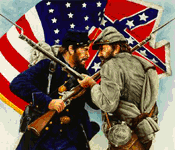 |
Civil War Battles |
|
State War Records |
| AL - AK - AZ - AR - CA - CO - CT - DE - FL - GA - HI - ID - IL - IN - IA - KS - KY - LA - MA - MD - ME - MI - MN - MS - MO - MT - NE - NV - NH - NJ - NM - NY - NC - ND - OH - OK - OR - PA - RI - SC - SD - TN - TX - UT - VT - VA - WA - WV - WI - WY |
The Battle of Lexington
December 18, 1862 in Lexington, Tennessee
 |
|||||||||||||||||||||
|
Union informants reported on December 16th that Brig. Gen. Nathan B. Forrest had crossed the Tennessee River west of Clifton, a community north of savannah, Tennessee. According to the report, Forrest, with 2,100 men, would raid in West tennessee and assault the Mobile & Ohio Railroad and the Mississippi central railroad supplying Maj. Gen. Ulysses S. Grant's Union campaign in Mississippi. Brig. Gen. Jeremiah C. Sullivan, commanding at Jackson, acted on other intelligence reports and on the 16th, dispatched Col. robert G. Ingersoll 28 miles east to command Union cavalry at Lexington, the probable first objective of forrest's 2nd raid. gathering Illinois, Ohio, and Unionist West Tennessee troops, and a 2-gun section of an Indiana battery, Ingersoll defended the town with about 706 men.
Forrest's cavalrymen marched 8 miles west of the Tennessee on the 17th, camped, and prepared to move north, then west on Lexington. Anticipating this approach, Ingersoll deployed pickets 5 miles east of town along beech Creek and ordered brigades burned on the 2 northwest-southwest roads crossing the creek to the southeast. Late on the 17th, Forrest's advance troops were sighted. Ingersoll pulled back to a position half a mile from Lexington and prepared to fight along the 2 roads, the more northerly one being called the State road, the more southerly called the Lower road. He positioned his 2 cannon north of the creek crossings. Uknown to Ingersoll, a Lt. Fox, with the force on Lower road, for unknown reasons failed to burn the bridge crossing hi front.
Maj. Otto Funke led troops 4 miles down the State road at dawn on the 18th, hit a large body of Confederates, and begun a fight lasting several hours. Forrest's troops, able to overrun Funke's men at any time, gave the impression of forming for a major assault. Intent on assaulting the Union left, Confederates instead sent the bulk of their forces up the Lower road, crossed the undestroyed bridge, and routed troops commanded by Col. Issac R. Hawkins. Ingersoll tried too late to mass his troops along the Lower road, was enfiladed on all sides, driven back to his cannon, and after repelling 3 charges was overrun. His West Tennessee troops fled the field.
Ingersoll became a prisoner along with 149 of his men. Both of his cannon were captured. Records of the number of Union and Confederate troops killed and wounded in the engagemente are niether complete nor reliable.
Though overwhelmed, most Federals gave a good account of themselves, according to Forrest's men. The prisoners were held 2-3 days, then paroled at Trenton, Tennessee. Those Federals who escaped alarmed Sullivan at jackson, stating that Forrest commanded a force as large as 10,000 men. This ensured Union timidity for the duration of Forrest's raid.
Books on The Battle of Lexington & the Forrest's West Tennessee Expedition
are available from Amazon.com
